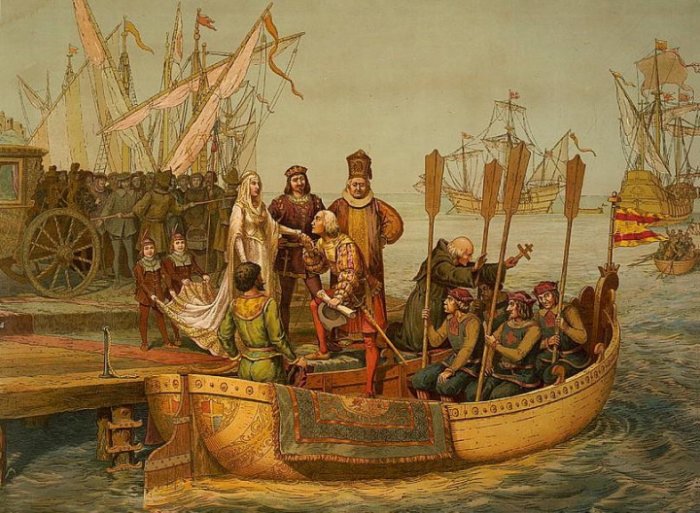Jan Bartek – AncientPages.com – In the spring of 1495, Charles VIII of France’s Italian campaign was disrupted by a severe outbreak of a mysterious illness. This disease, characterized by high mortality and lasting physical and mental impairments for survivors, rapidly spread across Europe. It is now widely considered to be the first recorded instance of syphilis.
Imaginary scene of Christopher Columbus bidding farewell to the Queen of Spain on his departure for the New World, August 3, 1492. Credit: Library of Congress Prints and Photographs Division, Washington, D.C. 20540 USA
The origins of syphilis have been debated for decades. The outbreak in the late 15th century occurred soon after Columbus and his crew returned from their expeditions to the Americas, leading some to speculate that interactions with new lands and peoples may have triggered this sudden emergence.
While many diseases traveled westward from Europe to the Americas during early colonial times—causing significant harm to indigenous populations—syphilis is one disease thought to have possibly made the reverse journey. The “Columbian theory” suggests this transatlantic transmission but remains contentious among scholars.
This theory faces challenges when experts examine skeletal remains from Medieval Europe displaying lesions typical of long-term syphilis sufferers or congenital infections. Several such skeletons found in Europe predate Columbus’s voyages in 1492, suggesting that syphilis might have existed there earlier.
Consequently, many researchers now propose that Europe’s history with syphilis began well before Columbus’s time and that other factors contributed to its late 15th-century pandemic spread. However, neither hypothesis has been definitively proven yet.
A study conducted by Bos and Johannes Krause, the director of the Department of Archaeogenetics at the Max Planck Institute for Evolutionary Anthropology in Leipzig, has made significant progress in addressing this ongoing debate.
Pathogen DNA retrieved from archaeological bone has the potential to tip the scales in support of one theory over another. It has already told us volumes about the deep history of plague, tuberculosis, leprosy, and smallpox, though unthreading the history of syphilis has proven more challenging.
“Several genomes from the syphilis family have been reconstructed from archaeological bone, but these haven’t been able to address core questions related to the pre- or post-Columbian theories surrounding syphilis,” says Kirsten Bos, group leader for molecular paleopathology at the Max Planck Institute for Evolutionary Anthropology.
The new study, conducted in collaboration with scientists and archaeologists from various countries across the Americas, concentrated on analyzing archaeological bones from these regions. The research specifically examined infections that resulted in lesion patterns resembling those of syphilis, evident from ancient time periods.
We’ve known for some time that syphilis-like infections occurred in the Americas for millennia, but from the lesions alone it’s impossible to fully characterize the disease,” comments Casey Kirkpatrick, a postdoctoral researcher and paleopathologist who contributed to the current study.
Syphilis Family Of Diseases In The Americas Pre-Dates ‘Columbus’
Bone pathology alone cannot determine whether the disease originated in the Americas or if it migrated from Asia during early human migrations to the Americas around 15,000 years ago. Utilizing advanced techniques, researchers have successfully recovered and analyzed five ancient genomes of the syphilis disease family from Mexico, Chile, Peru, and Argentina. Computational microbiologist and postdoctoral researcher Lesley Sitter tackled the challenge of assembling these ancient molecular puzzles. Despite preservation-related analytical challenges, they confidently established relationships between these extinct forms and current global health strains.
Skeletal element (upper hip) that yielded an ancient syphilis-like genome. Credit: Darío Ramirez
Syphilis belongs to a small group of diseases that includes yaws and bejel—both classified as neglected tropical diseases prevalent in equatorial regions worldwide. Postdoctoral researcher Rodrigo Barquera’s previous work with colonial Mexican archaeological bones confirmed syphilis and yaws’ presence in Mexico City by the 17th century. The latest ancient genomic data reveals that before Columbus’s arrival, the Americas were a center for diverse strains within this disease group.
“We see extinct sister lineages for all known forms of this disease family, which means syphilis, yaws, and bejel are the modern legacies of pathogens that once circulated in the Americas,” asserts Barquera.
“The data clearly support a root in the Americas for syphilis and its known relatives, and their introduction to Europe starting in the late 15th century is most consistent with the data,” adds Bos.
Following this period, there was a notable increase in cases of syphilis and yaws around AD 1500. This surge likely contributed to the widespread and severe outbreak in Europe during the 16th century. Human trafficking networks and European expansion into the Americas and Africa in the subsequent decades and centuries further enabled the global dissemination of these diseases.
“While indigenous American groups harbored early forms of these diseases, Europeans were instrumental in spreading them around the world,” she concludes.
See also: More Archaeology News
With support for an American origin of syphilis, how does the current narrative square up with the evidence of syphilis-like bone lesions that many claim to have identified in pre-1492 Europe?
“The search will continue to define these earlier forms, and ancient DNA will surely be a valuable resource,” comments Krause. “Who knows what older related diseases made it around the world in humans or other animals before the syphilis family appeared.”
The study was published in Nature
Written by Jan Bartek – AncientPages.com Staff Writer



